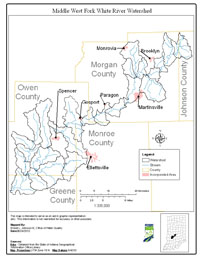Location
The Middle West Fork White River Watershed is located in southwest Indiana, draining approximately 361 square miles in Morgan, Owen and Greene counties. Major streams included in the Total Maximum Daily Load (TMDL) report are Middle West Fork White River, East, West and Grassy Forks of Clear Creek, Sycamore Creek, Highland Creek, McCormicks Creek, Stotts Creek, Rattlesnake Creek, East Fork of Fish Creek, Fish Creek, Raccoon Creek-Little Raccoon Creek, Raccoon Creek-Lick Creek, Lambs Creek, Goose Creek, White Lick Creek, Crooked Creek-Banta Creek, Beanblossom Creek and Indian Creek.
History
A comprehensive survey of the Middle West Fork White River Watershed was conducted by Indiana Department of Environmental Management (IDEM) from July 2001 to October 2001. The primary cause of impairment is Escherichia coli bacteria (E. coli). Pollution sources in the watershed include nonpoint sources from agriculture and pastures, land application of manure and urban and rural run-off, as well as point sources from straight pipe discharges, home sewage treatment system disposal and combined sewer overflow outlets.
Pollutants Addressed
TMDLs for the Middle West Fork White River Watershed are established for E. coli and will address 29 impairments. Some of the recommended solutions to address the impairments include storm water controls, point source controls, manure management and habitat improvements.
Timeline
Kickoff TMDL meetings were held on September 20, 2004 at the Morgan County Public Library, 110 S. Jefferson St., Martinsville, Indiana starting at 6:00 p.m. and on October 27, 2004 at the Owen County Public Library, 10 S. Montgomery St., Spencer, Indiana starting at 6:00 p.m.
A draft TMDL meeting was held on April 20, 2005 at the Owen County Public Library, 10 S. Montgomery St., Spencer, Indiana starting at 6:00 p.m.
The 30-day public comment period for the draft Middle West Fork White River Watershed TMDL began on April 11, 2005 and ended on May 11, 2005.
U.S. EPA under Section 303(d) of the Clean Water Act approved the Middle West Fork White River Watershed TMDL report on July 21, 2005 for 29 impairments. TMDL reports identify and evaluate water quality problems in impaired water bodies and propose solutions to bring those waters into attainment with water quality standards.

